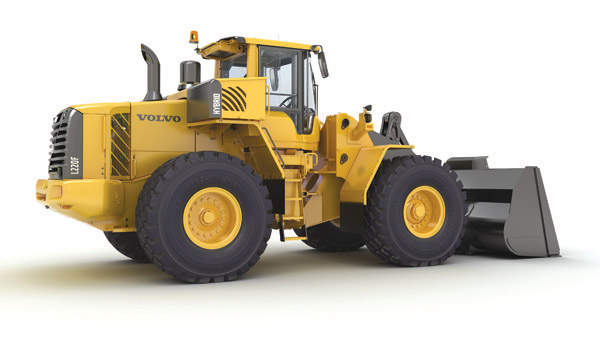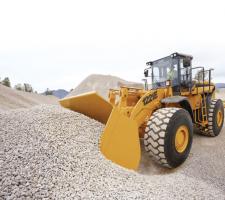
Spiralling fuel costs, demands for easy to operate equipment and calls for low maintenance are driving wheeled loader development
The initial cost of a new quarry machine used to be one of the main points when it came to deciding on which manufacturer's model to select, but that is beginning to change. Today quarry customers are demanding more fuel efficiency and lower maintenance to minimise total ownership costs, as well as easier to operate, more comfortable machines, and wheeled loaders are no exception.
Wheeled loaders are the quarry workhorse for loading operations both on the pit floor and the delivery yard. Increased use of wheeled loaders at the quarry face is fuelling demand for larger machines, while housekeeping and loading of delivery trucks is maintaining demand for medium sized machines.
Demand
Prospects of further growth in the larger wheeled loader market is driving the launch of machines such as
Development of our own larger wheeled loaders to meet this would take too long which is why we are looking at the M&A market."
Development
Like many other items of construction equipment it is new legislation that is helping to drive development and this is also true of wheeled loaders.
Changes to engine emissions regulations have already seen many quarry-sized wheeled loaders undergo redesigns to accommodate new power plants when the Stage IIIA regulations came into force several years ago. Further, and possibly more significant, changes will come when the next Stage becomes law for this power bracket in 2014.
"The next step in the emissions laws is more complicated than the last one," said
The tougher emissions levels are likely to call for post treatment of exhaust gasses so machines will have to accommodate extra tanks for the chemicals and it will place an extra burden on owners to ensure that not only the regular daily checks are carried out, but also that these post treatment systems are topped up.Production boost
Production at Earthline's Shellingford Quarry in Oxfordshire, UK has been boosted through the delivery of three new
Noise legislation has seen significant changes to wheeled loader design - both to the external shape and internally to the cab - as manufacturers work to minimise noise levels.
The next legislative change for wheeled loaders will come from the new EU Machinery Directive which is due to come into force next year. "The directive will help to standardise things such as access and egress systems and braking across EU countries but it is likely to create a cost challenge for both manufacturers and operators," said Douglas. "While the new legislation is helping to drive development of cleaner and safer machines, these are not items that the customer wants to pay for but the research and development involved is expensive. It is difficult to balance funding the development with not excessively raising machine prices."
Introduction of the newer engines to meet Stage IIIA regulations has brought greater fuel efficiency, which combined with the current high fuel prices, has made it easier for operators to see the innovation benefit in their bottom line.
The high cost of fuel is also driving development of hybrid powered machines and alternative drive systems.
Volvo has launched a hybrid powered version of its L220F wheeled loader. From an engineering perspective, hybrid power offers significant benefits in terms of quieter running, better fuel efficiency and possibly longer component life. However, the high cost of development may mean that customers buying into this technology may not see a return on their investment from the improved fuel economy alone.
Other manufacturers are looking to a more conventional solution to the cost of operation with improved drive trains. There seems to be a trend towards hydrostatic drives to deliver greater power transfer. Such drives are common on smaller machines but are now increasingly being used for larger wheeled loaders as they are known to offer better fuel efficiency than power shift systems.
Whole life costs
Many quarry operators now consider the cost of ownership and reliability a more important factor when it comes to buying a new machine, then the initial investment itself. "Customers now expect reliability with minimal down time and fewer service intervals," said Douglas. "In other words, the total life cost has to be minimal. In developed markets the initial cost of the machine is less significant than the availability and cost of parts and servicing from a local dealer." Some of the improvements in
reliability and reduced servicing have been made possible through the introduction of CANbus technology that allows the machine to be remotely monitored. This enables the local dealer to check the condition of the machine and carry out planned preventative maintenance to avoid breakdowns.
Further development
Looking ahead, Hitachi's Stuijt believes that the focus on improving fuel efficiency will be an ongoing theme for wheeled loader development. "Further emphasis on reducing fuel consumption is essential," he said. "I also think that high oil prices will drive further investment in hybrid power and maybe through the economies of scale, the cost of such machines will become more affordable." According to Stuijt, other future changes for wheeled loaders, as well as other quarry machines, are likely to include improved recyclability. "Whole life costs should actually cover the whole life of the machine and also improve reuse of parts when the unit has reached the end of its design life," he said.
















